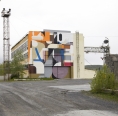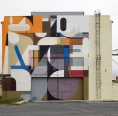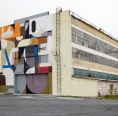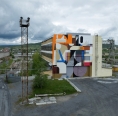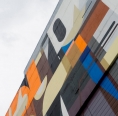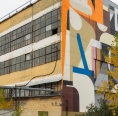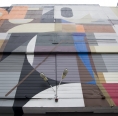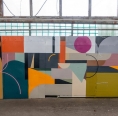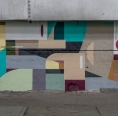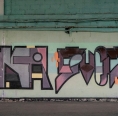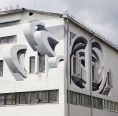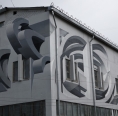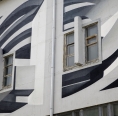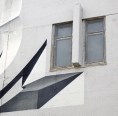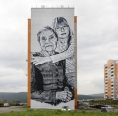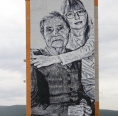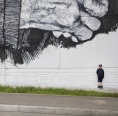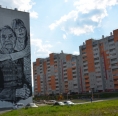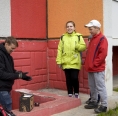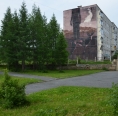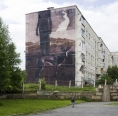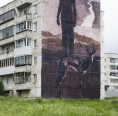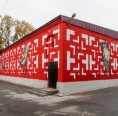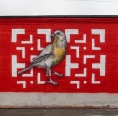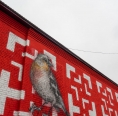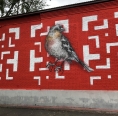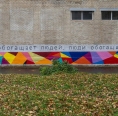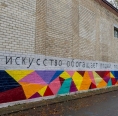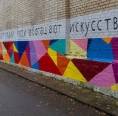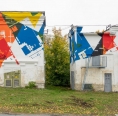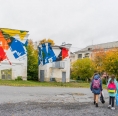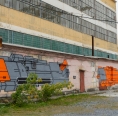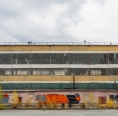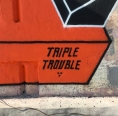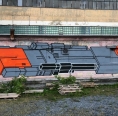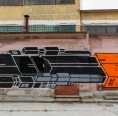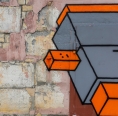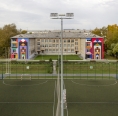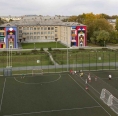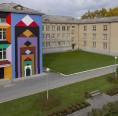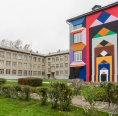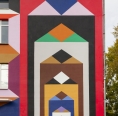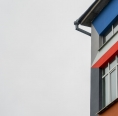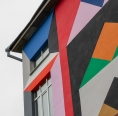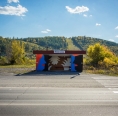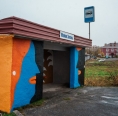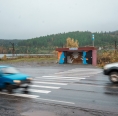-

SATKA STREET ART FEST 2018 — NEW FORMS
-
Address:
-
Partners:
From 5 June to 18 September Satka hosted the second International Festival of Street Art − Satka Street Art Fest.
The town became an open-air gallery where the façades were used as canvases and the collection included the works of the most popular world artists. Satka can be really called a centre of international street art: last year artists from Russia, Switzerland and Italy worked here, this year − from Russia, Germany, the Netherlands, Spain, Italy and the Republic of South Africa. The artists from different countries share their culture and outlook with Satka people, who become spectators and participants of this bright visual journey.
Unexpected Beauty of Abstraction
Being an architect by education, Alexey Luchko (Luka) has become one of the most progressive young Russian artists who started his creative career with graffiti. For over ten years, he has been drawing on walls and canvases, creating collages and 3D compositions from wood and other materials as well as digital works which always clearly manifest his unique style. He makes a sort of deconstruction of everyday images and then creates bright abstract ironic characters.
Now the work of Luka is a part of industrial Satka. In June, he created the first and the biggest in this year mural on the façade of the Hangar − the former BelAZ repair shop, which has being transformed into the main art site of the town. Inspired by the brutal landscape of the old plant, Luka has integrated his grotesque collage into the area making it brighter.
Another young Moscow artist − Danila Shmelev known as Shozy − has decorated the main building of Satka post office. Danila is a talented artist of anamorphosis. To see in space or on a plane something which does not exist is the main feature of 3D illusion artist.
Post office is at first sight a dull grey panel building with numerous windows, rectangular decorations and signboards. It is however the rectangularity which inspired the artist to ‘break’ this severe routine and grey formality and create an illusion of other spaces and planes. Using only the shades of the very same grey Danila has completely changed the visual architecture of two walls having created the new look of modern futurism called Metamorphoses. The new depth and unusual round shapes, plenty of details and a new view from each new angle make everyone to look at these walls again and again.
Changing the Destiny
Hendrik Beikirch (ECB) is a famous German artist, the author of the largest street portrait in Asia, creating giant photorealistic portraits of people. Black&white technique of his works allows to take away everything irrelevant and keep only emotion. He values the story of a person reflected in the glance, facial expression, wrinkles. For his project in Satka, Hendrik chose two people living in the town: Maria Perfilyeva and Arina, a grandmother and a granddaughter. This is the first double and also female portrait in the creative career of the artist. In their photo, he was stung by the warmth and close connection through generations.
Working on Maria and Arina mural on the façade of a block of flats, Hendrik gathered numerous inquisitive glances. Every time the platform got down he was mobbed by people and everyone wanted to ask something or discuss his work. And Hendrik always answered with smile and attention. However the main part of his new audience consisted of Satka schoolchildren. Hendrik amazed the children with his openness, kindness and attitude to art. He made a revolution in their lives. They were patiently waiting for every meeting with him, gave him the present made by themselves, brought treats, found the phrases in the dictionary to communicate without the assistance of the organizers. When Hendrik flew away, one boy, Vasya Suslov, found a plywood sheet in wrecked garages and drew the plane in which Hendrik is sitting by the window ‘flying to his Germanland’. Vasya’s work inspired his friends and they started drawing together. They found materials among the wreckage and drew portraits of the artist and then the star of Hendrik.
At the moment, the young artists have more than 20 works. They make a picture of every new drawing and through the organizers send it to Hendrik accompanied with a cheerful audio message. Hendrik confesses that he is really touched by this story. In spring, he will come to the children to hold a workshop and teach them his technique.
Now children accompany every project. They have been filled with the new art form - street art. They currently know many artists who came to Satka and try not to omit any event.
Submersion into Another Culture
Mural on the façade of a block of flats in Satka western district by Ricky Lee Gordon, a young self-taught artist from the Republic of South Africa, has become the most resonant project of the festival. Ricky is in the list of 200 most powerful young people in South Africa and one of ‘11 best street artists’ together with Banksy according to National Geographic. The work in Satka is his first project in Russia.
In his works Ricky investigates the nature of duality and interconnection, focuses on the most relevant social issues and the universal truth in dark shades. The main objective of his work is creation of an imagery reflecting a connection of the person − an artist or a local person − and the place. That is why on the way from the airport he realised that the sketch he prepared is not appropriate: “Going to Satka at dawn I was startled by the mountain landscape, holts and rivers. I wanted to express my admiration of nature in the work. That is why I changed the sketch”.
Now there is a picturesque plot on the wall of the block of flats and an inscription in two languages: “Sunrise. Sunset. We are all under one Sun”. “I have painted a shadow figure of a man as an abstract image of everyone living on the Earth and an antelope as a symbol of African vastitude. The river and mountains are the tribute to the splendid Russian nature. All these symbolize the interconnection of the nature and the man, the man and the man on the whole planet. The way we live “under one Sun.” The art can unite and change the perception of the world. That is why I make graffiti.”
Reminding of Dream
Three birds against the background of red and white labyrinth pattern are looking from the walls of school no.4 gym. This is the work of Pablo Pelluz, a Spanish artist, the first project of the festival in Proletarskaya Street, the main street of the town.
“My work is a metaphor. The birds I created do not fly. Through them I try to show the society. People are often not free and cannot live as they like while they always have ‘wings’ − the possibility to implement their dreams. And even the outer beauty does not guarantee happiness and success.”
The works of Pablo are generally a realistic portrait of everyday life details usually unnoticed by others. Using neat line he creates fragile creatures: butterflies, birds, fish. On the gym façade Pablo drew a bee-eater, a chaffinch and a linnet − the birds listed in Red Book. Drawing the critically endangered species, Pablo reminds about them invoking people to think about the problem of extinction and to be more careful with the nature and its fragile beauty.
To all participants of his workshop Pablo suggested to talk about the beauty through the prism of art on another school façade. Girls and boys were happy to paint the wall enthusiastically hunting for the brightest spray paint. “The art enriches the people. The people enrich the art”, a simple and beautiful truth symbolising this symbiosis of child inclination to everything new and the desire of artists all around the world to create and share their knowledge and ideas. It can be said that this is the very target of MY SATKA festival under which the second international Satka Street Art Fest was held − to reveal new sides of the art to people to awaken their desire for the beauty often lost amid problems and routine.
Keeping the Internal Beauty
The works of ZEDZ, a Dutch artist, decorate the walls all around the world. Now they are on Satka façades as well. ZEDZ is one of the European graffiti pioneers: he started writing his pseudonym on walls in the end of 1980s and his love to typographics and art in general, he says, is still closely connected to this subculture. In his works he tends to combine graffiti, typographics, architectural forms, elements of graphic and industrial design. He actively experiments with various materials and techniques.
ZEDZ’s visual style is very recognizable: punched patterns as if cut in the bright colour layers with a sharp knife which overlapping create a special pattern, depth and rhythm. ZEDZ applies the pattern to the walls using a spirit level and paints.
The plot for two transformer vaults near Magnezit Cultural Centre is the result of two decades of abstract typographics which turned into an abstract visual language. The murals directly refer to the architecture of the buildings and their elements. Rethinking and reconstructing these elements in colour − right angles of decoration, relief − the artist has left a half of the building unpainted (50-50) to preserve their original image, their architectural essence and authenticity which ZEDZ values so much. He deliberately used the colours unusual for the area − blue, orange, yellow, red − in contrast to classical pastel shades of residential buildings and the Cultural Centre.
This is not the only project of the artist in Satka. Three ‘guards of the plant’ − three robots with guns, three graffitis from letters ZEDZ in corporate colours of Magnezit Group − watch the production chimneys and the mine from the side face of the Hangar. This is the final and the largest series of robots from the personal project of the artist − Triple trouble. He has been painting such graffitis for a long time − the letters of the pseudonym harmoniously make the ‘bodies’ of the robots. The Trouble series is a visual story about adventures of the artist.
ZEDZ decided to create robots as soon as he had finished his main project. The organizers had only to offer the appropriate location. The future art site of the town, the place for creative work and search for new forms and meanings suited the best. It is ZEDZ’s graffiti which started the visual decoration of the area near the Hangar. The artist also suggested some colour solutions for other facilities in this area. Some of them have been already implemented this year.
Ddddddddom
One of the most popular modern artists − Agostino Iacurci − became the author of transformation of school no.4 façades.
Simplifying the forms and increasing the contrast of colours and surrounding area, Agostino creates monumental paintings, canvases and installations which at first sight might look like illustrations of a children’s book. However his laconic and ironic plots are not aimed at a certain audience. Through these works full of weird forms and characters Agostino wants to communicate with each spectator using visual lexicon which elements can seem very simple and flat. In fact these are skilfully concentrated everyday stories which we often look over in fast-paced modern life.
Two equal façades are a special project for Agostino. He has long been dreaming about twin paintings and fulfilled his dream in Satka. The composition directly follows the contours of the façades with a colour echo into the depth of the building. 7 ‘houses’ on each wall − the visual play of forms and volumes, brightness and space, built on the architectural idea. The ‘houses’ are put one into another as in a matrioshka doll. They set a rhythmic pace to the spectator glance − D…d…d…d…d…d…d…dom. The colour code is based on the style and design of Proletarskaya Street which both façades face as well as the picturesque nature of Ural.
The second Agostino’s project is a bus stop shelter. Two fragments of the bus stop inspired the artist to create the composition in his signature style − a traditional plot with shadow figures in contrast colours. Now there are two similar images here − a man and a woman as though they have frozen up when talking. The background for the ‘dialogue’ is the internal wall of the bus stop painted by Agostino in floral pattern.
Within the framework of the festival, Magnezit Museum hosted the exhibition of the member artists, City as an Object of Art. Then a series of documentaries filmed during the first Satka Street Art Fest in 2017 were shown and meetings with the film directors were held. The documentaries about the work of each of three duets of artists were filmed by the students of S.A. Gerasimov Russian State University of Cinematography. The workshop was headed by Sergey Valentinovich Miroshnichenko, a Russian documentary film director. Finally, 3 films were made which characters − artists, town people and children − talk about contemporary art and its interpretations, about honesty and inspiration, about perception of the world and yourself. The films had their premiere in the Film Centre in Moscow.
International festival MY SATKA in June this year has won the contest of the President Grants Fund. The festival is aimed at transformation of the existing urban environment elements into modern and convenient art spaces. Two main directions − creation of small architectural forms and transformation of the exterior of existing buildings by means of street art − are now called ARCH-SATKA and ART-SATKA.
The festival is held with support of Magnezit Group, the President Grants Fund and the Administration of Satka Municipal District.
Photo by Agostino Iacurci, Alexey Luchko, Danila Shmelev, Hendrik Beikirch, Ricky Lee Gordon, Alexander Andrievich, Sergey Poteriaev, Denis Shakirov, Anna Filippova.
-
26.08 - 26.08
DIARY OF THE THIRD INDUSTRIAL BIENNALE
-
28.11 - 28.11
MY SATKA FESTIVAL WINS THE CONTEST OF CORPORATE VOLUNTEER PROJECTS
-
13.10 - 15.10
COOPERATION WITH VGIBL NAMED AFTER M.I. RUDOMINO

